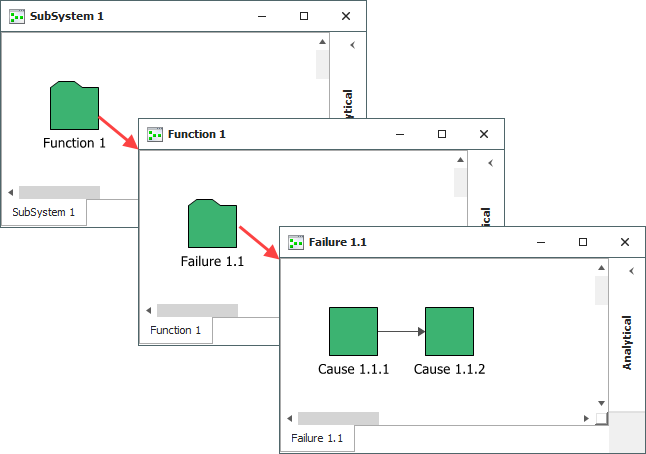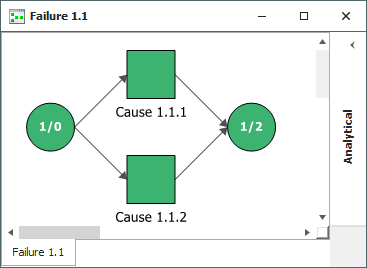FMRA Diagrams and Reliability-Wise Configurations
By default, the records in an FMRA are assumed to have a reliability-wise series configuration. In other words, if any failure mode occurs or any component fails, then the entire system fails. However, you can use BlockSim's FMRA diagrams to represent more complex configurations.
To do this, choose FMRA > Refresh > Synchronize FMRA to refresh the FMRA and create the associated diagrams and blocks.
![]()
Note the following about FMRA synchronization:
- Changes that are made in BlockSim are synchronized and propagated to XFMEA/RCM++ automatically, although you may need to refresh the view to see them (View > Refresh).
- When records are added to or deleted from the current
FMRA in XFMEA/RCM++, the changes will not be displayed
in BlockSim's FMRA hierarchy until you synchronize the FMRA
(FMRA > Refresh > Synchronize
FMRA). This will refresh the FMRA hierarchy and create
the associated diagrams and blocks. Depending on the changes
that were made in XFMEA/RCM++, this may affect your FMRA
diagrams.
Any records deleted from the FMRA in XFMEA/RCM++ will be represented in the FMRA diagrams by 1/n nodes when the diagrams are resynchronized. Such nodes are placeholders that have no mathematical effect within the diagram; they simply allow the diagram to maintain any customized configurations that may have been created. The name of the deleted record is shown in each node block's description. - If you no longer wish to synchronize the FMRA with BlockSim diagrams, you can choose View > FMRA > Disassociate FMRA to delete all of the FMRA diagrams and close the FMRA view. You can resynchronize at any time.
Working with FMRA Diagrams
It is important to note that the diagrams that you work with from within the FMRA are distinct from the other diagrams in BlockSim’s current project explorer. FMRA diagrams relate to the analysis being performed in the project using XFMEA/RCM++. They are accessible only via the FMRA view, while all other diagrams are accessible only from the Standard tab of BlockSim’s current project explorer.
Each record in the FMRA hierarchy represents a reliability block diagram, with the exception of the lowest-level record in each branch, which represents a block in the parent diagram. The levels of the hierarchy are expressed using subdiagrams. For example, consider the FMRA hierarchy shown next.

Now, let's look at the branch of the FMRA that begins with SubSystem 1. The associated FMRA diagrams are:

As you can see, the causes are assumed to be in a series configuration, as is the case with all reliability-wise configurations built in XFMEA/RCM++. Working with the FMRA in BlockSim allows you to change the reliability-wise configuration. For instance, let's imagine that the causes are actually in a parallel configuration—in other words, the item will not fail if only Cause 1.1.1 happens OR only Cause 1.1.2 occurs, but the item will fail if both occur. To represent this, you would change the Failure 1.1 diagram as follows (with the first node acting as a starter block):

Analytical and Simulation FMRA Diagrams
By default, the FMRA diagrams are created as . You can choose FMRA > Inheritance > Toggle Diagram Type to change them to , or to change simulation diagrams to analytical ones. This command changes all of the FMRA diagrams in the project; you cannot have both analytical and simulation FMRA diagrams in the same project.
Like any other RBD, the diagram type affects the available functionality, both in terms of configuration and results. For instance, maintenance groups can be assigned only in simulation RBDs. You can analyze or simulate an FMRA diagram just as you would any other RBD, and can generate plots and QCP results for each diagram. You also can perform analytical calculations or simulation at the FMRA level.